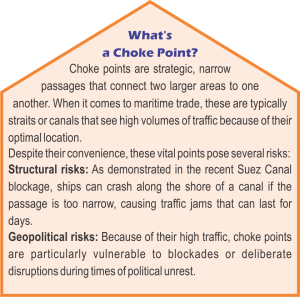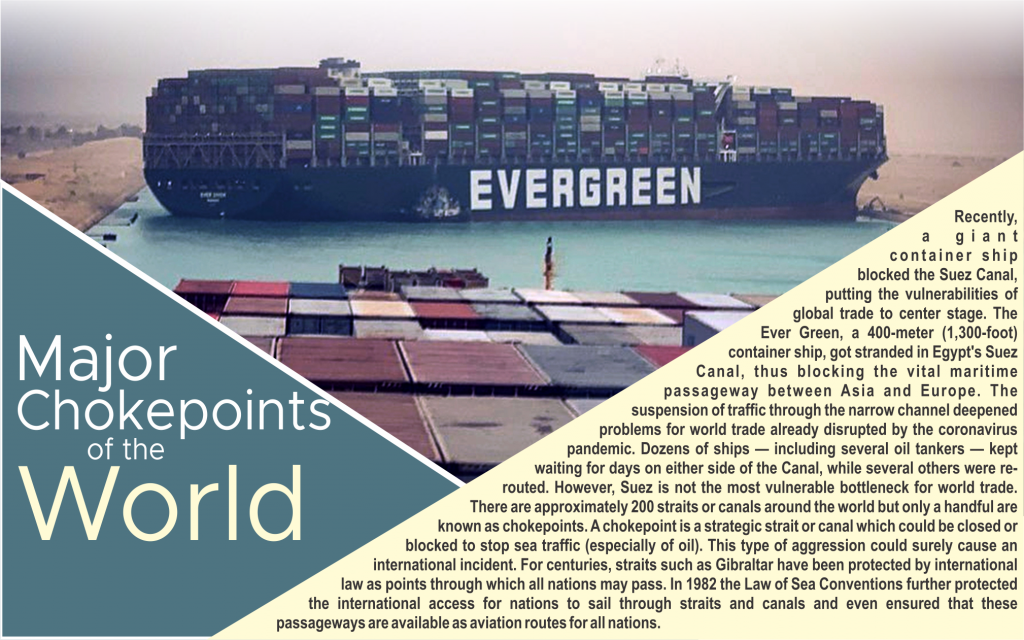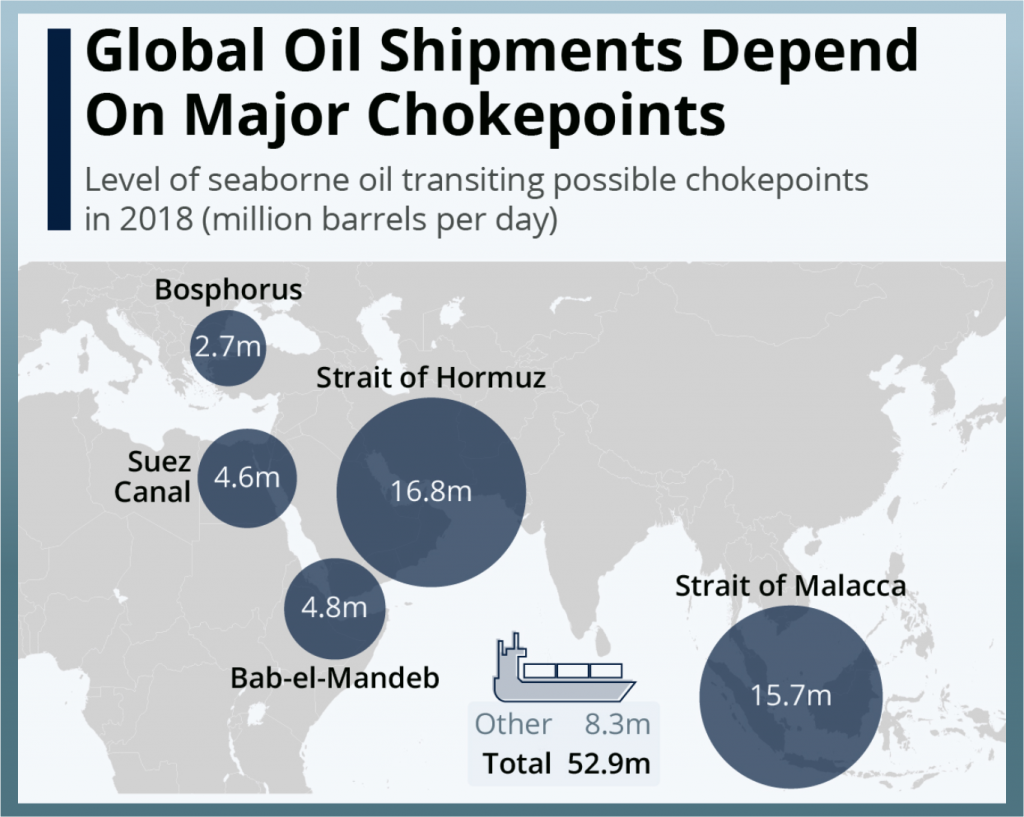Major Chokepoints of the World
1. Strait of Gibraltar
This strait between the Mediterranean Sea and Atlantic Ocean has the United Kingdom’s tiny Gibraltar Colony as well as Spain on the north and Morocco and a small Spanish colony on the south. US warplanes were forced to fly over the strait (as protected by the 1982 conferences) when attacking Libya in 1986 since France would not allow the US to pass through French airspace. Several times in our planet’s history, Gibraltar was blocked by geologic activity and water could not flow between the Mediterranean and Atlantic so the Mediterranean dried up. Layers of salt at the bottom of the sea attest to this having occurred.
 2. Panama Canal
2. Panama Canal
Completed in 1914, the 80-kilometre Panama Canal spans the narrowest part of Panama and connects the Atlantic and Pacific Oceans, reducing the length of the journey between the east and west coasts of the United States by 8000 nautical miles. One of world’s busiest shipping routes, it has historically handled about 5% of world trade and nearly 14,000 transits were made last year.
In 2016, Panama opened the long-delayed $5.4 billion expansion, which triples the size of ships that can travel the canal. In theory, 98% of the world’s shipping can now ply the route, avoiding the lengthy and hazardous Cape Horn route around the southern tip of South America. Although the canal isn’t subject to the same geopolitical risks as other chokepoints, the coronavirus pandemic and adverse weather have created bottlenecks in recent months, delaying the transport of container ships and supplies of gas from the US Gulf Coast.
The United States retains control of the 10-mile wide Canal Zone until the year 2000 when the canal is turned over to the Panamanian government.
3. Strait of Magellan
Before the Panama Canal was completed, boats travelling between the US coasts were forced to round the tip of South America. Many travellers risked disease and death by attempting to cross the dangerous isthmus in Central America and catch another boat to their destination to keep from sailing the extra 8000 miles. During the California Gold Rush, in the mid-19th century, there were many regular trips between the east coast and San Francisco. The Strait of Magellan lies just north of the southern tip of South America and is surrounded by Chile and Argentina.
4. Strait of Malacca
The 900-km long strait is Asia’s primary chokepoint and one of the world’s busiest shipping lanes. The waterway links Asia with the Middle East and Europe, carrying about 40% of global trade. More than 100,000 vessels ply the waterway every year.
At its narrowest point off Singapore, the strait is only 2.7 kilometers wide, creating a natural bottleneck, as well as potential for collisions, grounding or oil spills.
Some 16 million barrels per day of oil flowed through the waterway in 2016, making it the world’s second most important energy passageway.
The strait has become increasingly important strategically to Beijing, with nearly 80% of China’s crude oil imports passing through, from the Middle East and Africa.
5. Bosporus and Dardanelles
Bottlenecks between the Black Sea (Ukrainian ports) and the Mediterranean Sea, these chokepoints are surrounded by Turkey. The Turkish city of Istanbul is adjacent to the Bosporus in the northeast and the southeast strait is the Dardanelles.
6. Suez Canal
This artificial waterway connects the Mediterranean to the Red Sea and prevents ships from having to pass through the Cape of Good Hope, off South Africa. The canal knocks about 8,900 kilometres off a ship’s journey time.
The Egyptian government expanded the canal in 2014, almost doubling the number of ships that can use the waterway per day from 49 to 97. Despite this, some supertankers can still not ply the canal, and some have to offload part of their cargo onto smaller vessels and reload at the other end.
Suez saw about 12% of world trade volume pass through last year. The Suez Canal Authority reported that a record of 18,880 ships traversed the passageway in 2020, carrying more than 1 billion tons of cargo. At least two other ships have got stuck in the canal since 2008 — one forced a three-day closure.
The canal is also seen as highly vulnerable to political unrest in the Middle East. However, the Arab Spring and subsequent fall of Egyptian President Hosni Mubarak in 2011 had little impact on traffic. In 2013, Cairo said it had foiled an attack on a container ship which was aimed at disrupting shipping in the busy Suez Canal.
7. Strait of Hormuz
The sea passage between the Persian Gulf and the Gulf of Oman that leads to the Indian Ocean is the most critical chokepoint for oil and gas.
Some 167 kilometres (90 miles) long, about a quarter of seaborne-traded oil and a third of the world’s liquefied natural gas (LNG) passes through the strait.
The route is particularly vulnerable due to Middle East geopolitics. The strait connects many different powers and oil market players, including Saudi Arabia, Iran, the United Arab Emirates, Kuwait and Iraq.
The actual width of the fairway for the huge tankers is roughly 3 kilometres in both directions, meaning the waterway could be easily controllable during a conflict.
During the 1980-1988 Iran-Iraq war, the two sides sought to disrupt each other’s oil exports plying the strait.
Iran has repeatedly threatened to disrupt oil shipments through the strait in retaliation for US sanctions aimed at its energy exports. At one point, Tehran threatened to mine the waterway.
In May 2019, four vessels — including two Saudi oil tankers — were attacked off the UAE coast near Fujairah, just outside the strait.
In January this year, Iran seized a South Korean-flagged tanker in Gulf waters and detained its crew.
8. Bab-el-Mandeb
The Bab-el-Mandeb Strait is another primary waterway for the world’s oil and natural gas. Nestled between Africa and the Middle East, it connects the Mediterranean Sea (via the Suez Canal) to the Indian Ocean.
Like the Strait of Malacca, it’s well known as a high-risk area for pirate attacks. In May 2020, a UK chemical tanker was attacked off the coast of Yemen—the ninth pirate attack in the area that year. Due to the strategic nature of the region, there is a strong military presence in nearby Djibouti, including China’s first-ever foreign military base. The type and degree of risk varies, depending on location.
 Jahangir's World Times First Comprehensive Magazine for students/teachers of competitive exams and general readers as well.
Jahangir's World Times First Comprehensive Magazine for students/teachers of competitive exams and general readers as well.




